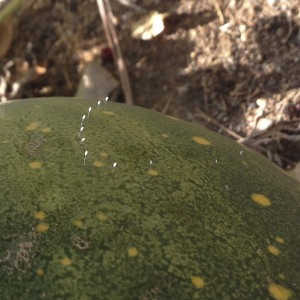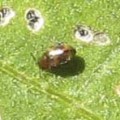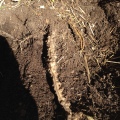Sap-sucking insects frequently found in vegetable and ornamental gardens, sometimes causes leaf to become distorted, or reduces crop production. Viruses can also be transmitted by whiteflies.
Physical Description
- clouds of small white insects fly up when plant is disturbed
- Tiny oval yellowish to green scale-like insects fasten to leaf undersides
- Sap sucking insects
Species & Taxonomy
- Kingdom:
- Phylum:
- Class:
- Order:
- Family:
- Genus Species:
- Most common:
- Trialeurodes vaporariorum, greenhouse whitefly
- Bemesia argentifolii, Silverleaf or Sweet potato whitefly
- Most common:
Lifecycle
- Develop rapidly in warm weather
- breed all year round, moving from one host to another
- Tiny, oblong eggs are laid on the underside of the leaf
- 1st stage larvae are called crawlers, and are barely visible, even with a hand lens; they have antennae and many legs
- After molting, they lose the legs and antennae; these later immature stages look like scale: oval, flattened and don’t move
- After going through complete metamorphosis with a pupal stage, the adults are whitish yellow with dull white wings
Plants Affected
Wide host range, including many weeds and crops
Plants Unaffected
- Not normally a problem for fruit trees (except citrus)
Geographical Range
Signs & Symptoms
Whole Plant
Leaves
- large numbers of whiteflies can cause the leaves to yellow or appear dry
- whiteflies secrete honeydew, like aphids, which make the leaves sticky, or get black sooty mold
- one of the whiteflies, Bemesia argentifilii, injects a toxin which causes the leaf to distort
Flowers
Fruit
Roots/Tubers
How to Positively Identify
Treatment
Prevention & Control
Cultural Controls:
Habitat:
Temperature & Humidity:
- Whiteflies develop rapidly in warm weather, and populations can build up quickly
Mulching & Cultivation Practices:
- aluminum foil mulches or silver-painted clear plastic mulches will repel whiteflies, especially away from small plants
- removing heavily infested leaves, where you see lots of the non-moving larval and pupal stages will help reduce the whitefly population
- Controlling dust and ANTS helps to keep whitefly populations down (ants protect whiteflies from their natural enemies)
Natural Enemies & Biological Controls
Whiteflies have many natural enemies, but if pesticides or dust has built up, the natural enemy balance can fall in favor of the whitefly, resulting in whitefly outbreaks.
Insect Predators
- lacewings
- bigeyed bugs
- minute pirate bugs
Insect Parasites:
Parasitized whitefly pupae are black or dark orange; you can also see empty pupal skins with a round exit hole – this means the parasite rather than a healthy whitefly popped out. T-shaped hatches are how the whitefly emerges.
- Encarsia spp. – only effective in greenhouses
Animals:
Reptiles:
Barriers
Traps
- Yellow sticky traps will trap adults
- mount them on sticks or stakes close to the plant, since whiteflies don’t fly very far, with the yellow sticky trap at the level of the infestation
- sticky side should face the plant, but be out of the direct sun
- many traps may be needed; as many as one trap for every two large plants
- Tanglefoot or Stickem can be purchased to make your own traps, but petroleum jelly, mineral oil, or one part household detergent also work and are easier to clean off
- Vacuums
- small, hand-held, battery-operated vacuum cleaners are effective at removing adults off leaves or sticky traps.
- vacuuming should be done in the early morning, or when it’s cool out, which is when they are most sluggish
- kill the whiteflies that were vacuumed up by freezing them overnight
Sprays & Dusts
Use of pesticides to control whiteflies should be avoided, since they don’t seem to be very effective against whitefly and whiteflies quickly build up resistance to them. Also, they kill the natural enemies of the whitefly.
- Insecticidal oil
- effective when applied properly, making sure to get the undersides of all the infested leaves (usually the lowest leaves)
- Insecticidal soap
- use when temperatures are cool to prevent damaging the plant
Sources:
- Pests of the Garden and Small Farm, pp: 113, 231




